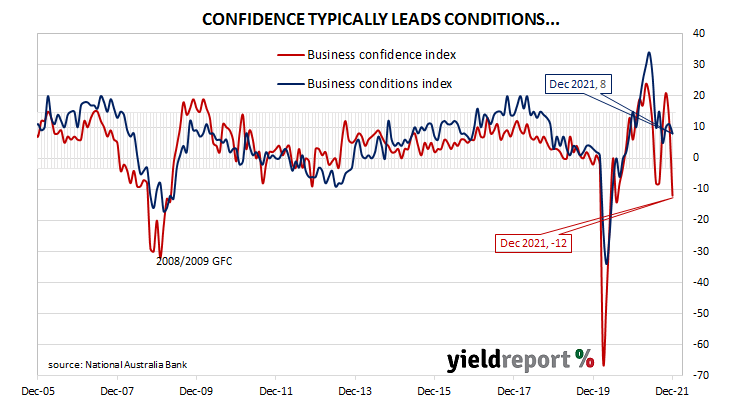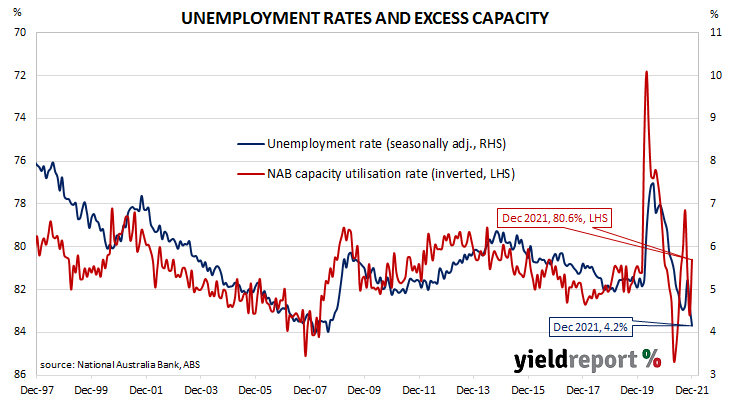Summary: Business conditions deteriorate slightly in December; noticeably larger fall in confidence; businesses facing “growing worker shortages”; capacity utilisation rate drops; 6 of 8 sectors of economy at/above respective long-run averages; price pressures continue.
NAB’s business survey indicated Australian business conditions were robust in the first half of 2018, with a cyclical-peak reached in April of that year. Readings from NAB’s index then began to slip, declining to below-average levels by the end of 2018. Forecasts of a slowdown in the domestic economy began to emerge in the first half of 2019 and the index trended lower, hitting a nadir in April 2020 as pandemic restrictions were introduced. Conditions improved markedly over the next twelve months, only to revert back to more normal levels in the latter part of 2021.
According to NAB’s latest monthly business survey of over 390 firms conducted over the first two weeks of January, business conditions have deteriorated slightly. NAB’s conditions index registered 8, down from November’s revised reading of 11.
“The fall in business conditions was driven by the employment component, which fell despite strong jobs growth reported in official data, reflecting the complexity of the labour market situation as businesses faced growing worker shortages and the prospect of a ‘shadow lockdown’ through the summer,” said NAB senior economist Brody Viney.
Business confidence also deteriorated but the change was noticeably larger. NAB’s confidence index fell from November’s reading of 12 to -12, a reading well below the long-term average. Typically, NAB’s confidence index leads the conditions index by approximately one month, although some divergences have appeared in the past from time to time.
The report was released on the same day as the December quarter’s CPI figures and Commonwealth Government bond yields increased on the day. By the close of business, the 3-year ACGB yield had gained 5bps to 1.46%, the 10-year yield had inched up 1bp to 1.97% while the 20-year yield finished 3 bps higher at 2.48%.
In the cash futures market, expectations of a change in the actual cash rate firmed a little in favour of earlier rate rises. At the end of the day, contract prices implied the cash rate would rise gradually from the current rate of 0.050% to 0.14% by April, then increase to 0.58% by August and then to 1.25% by February 2023.
NAB’s measure of national capacity utilisation dropped from November’s figure of 83.2% to 80.6%. Six of the eight sectors of the economy were reported to be operating at or above their respective long-run averages. The transport/ utilities and recreational/personal services sectors were the exceptions.
Capacity utilisation is generally accepted as an indicator of future investment expenditure and it also has a strong inverse relationship with the unemployment rate.
The report also contained several references to inflationary pressures. “Price pressures also continued in December, with both reported labour and purchase cost growth near record levels,” said Viney. Wholesale prices increased “from an already high rate” while retail prices increased at “2% in quarterly terms”, or over 8% when annualised. “With significant disruption to supply chains and labour markets, price pressures are to be expected and the key question will be how quickly, if at all, these pressures abate over coming months.”



